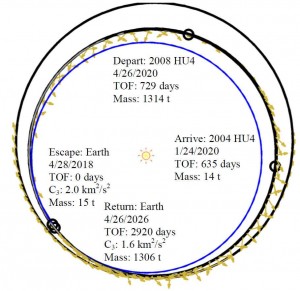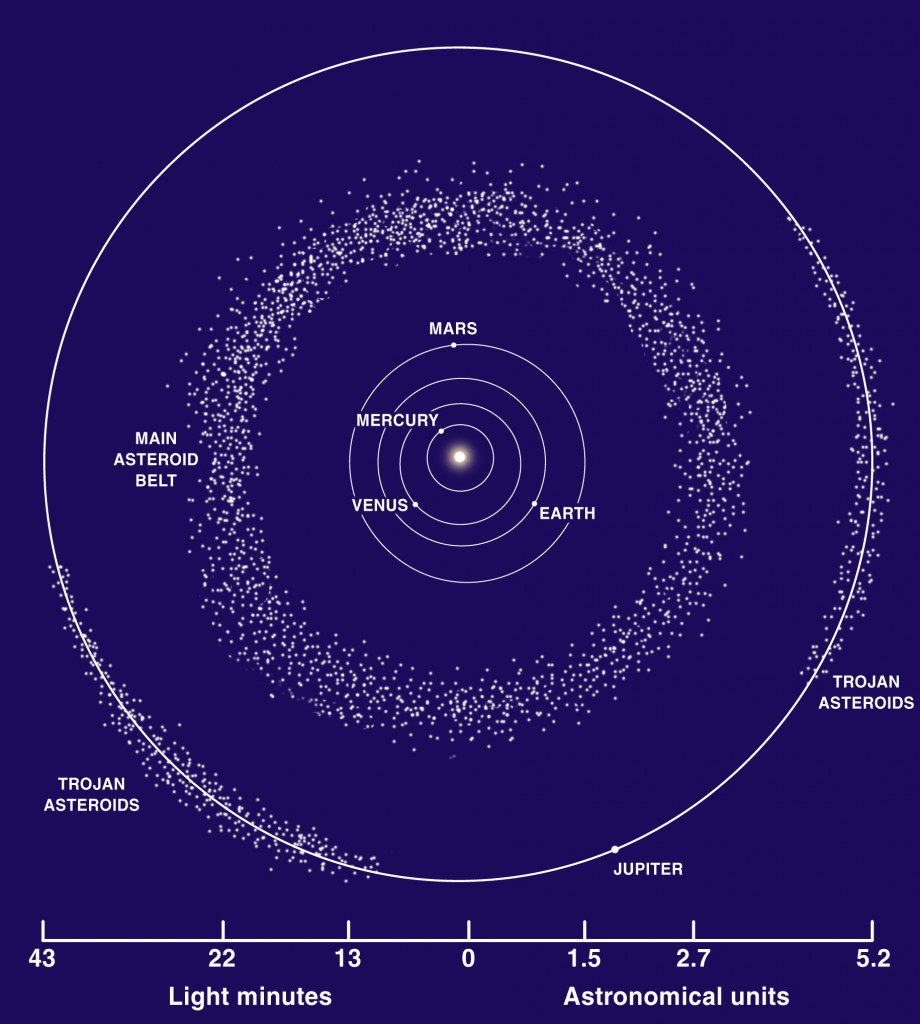The previous post discussed retrieving asteroids and what size we want to bring back to Earth. This post discusses the location and trajectory of an asteroid we could retrieve.
Families of Asteroids
The vast majority of the asteroids are in the Main Asteroid Belt between Mars and Jupiter. Why? Because (we surmise) the gravitational “stirring” caused by Jupiter, the largest planet, has kept the material in that orbital band from condensing into a planet. The largest asteroid in the main belt is the protoplanet Ceres, classified as a dwarf planet. The Main Belt also includes protoplanets Pallas and Vesta, not quite large enough to be dwarf planets, plus many smaller rocky bodies including fragments of larger bodies that had collided and broken apart.
A little further out in the solar system, at the orbital distance of Jupiter, are the Trojan asteroids that reside in 4th and 5th Lagrange points of the Sun-Jupiter gravity field. To state it simply, they are at the same distance from the sun as Jupiter, but they are clustered in two groups in front of and behind Jupiter, respectively.
Between the main asteroid belt and Jupiter are the Hilda family of asteroids, which are in orbital resonance with Jupiter. Here is a cool video showing the Hildas:
Moving inbounds toward the sun we will notice the Mars-crosser asteroids, which cross (or at least graze) the orbit of Mars. Some of these have very eccentric orbits and so they also cross the orbit of the Earth. All the asteroids that cross the Earth or at least come close to it, whether they also cross Mars or not, are classified as Near Earth Objects (NEOs) or more particularly Near Earth Asteroids (NEAs). Looking even closer to the sun we notice the Venus-crosser and the Mercury-crosser asteroids. Asteroids like all these in the inner solar system aren’t very numerous because they can’t survive very long before crashing into a planet (or the Moon) or before being gravitationally whipped out of the solar system entirely, so it is believed they are continually replenished from the asteroids of the main belt, Jupiter flinging a small fraction of them into the inner solar system. NEAs are therefore a sampling of the main belt and by studying them we can learn about the history of protoplanets in the main belt and therefore about planetary formation processes in general.
The Cost of Bringing One to Earth
As you can imagine, retrieving asteroids from the main belt is probably a bit more expensive than retrieving ones much closer to the Earth. It takes more propellant (i.e., the fuel and oxidizer that are burned in the rocket engine) to move an asteroid from farther away than it does if the asteroid is nearby. And it costs more money to launch all that extra propellant up from the Earth to even begin the mission. The kind of asteroid that can we afford to bring back to Earth — how big and from how far away — can therefore be calculated in terms of how much propellant it takes to go out and bring it back.
If we know how much the asteroid weighs, and how much velocity change we need to impart to the asteroid to properly change its orbit, and what kind of propellants we want to use to do that, then the rocket equation tells us the mass of propellant we will need to get the job done. It turns out that for a main belt asteroid — let’s say one near Ceres — to fall down toward the sun into an orbit near the Earth, we need to slow it down by about 4.9 km/s. As it falls toward the Earth it will be speeding up again, so to get it to match the Earth’s orbit and rendezvous with the Earth we need to slow it down by another 4.9 km/s after it arrives, so all total it needs its velocity changed by 9.8 km/s. If the asteroid has a mass of 500 tons (and let’s assume the spacecraft mass is negligible by comparison), and if we use liquid hydrogen and liquid oxygen as the propellants, then the total mass of propellant we will need to bring it from Ceres down to Earth is almost 4,000 tons! That’s a lot, and unfortunately it’s not the end of the story. To send that much propellant from low Earth orbit all the way out to Ceres so that we can then bring the asteroid back would require even more propellant. All total, we would need to launch 35,900 tons of propellant from Earth, and assuming a launch cost of $4,000/kg the mission will cost almost 144 billion dollars, not including spacecraft development and mission operations costs! That’s 144 billion dollars in propellant launch costs alone!
To bring back an asteroid from near Mars orbit would take a velocity change of only about 5.3 km/s, but the cost of launching the greater than 3700 tons of propellants would still be about $15B. That’s much less than bringing back an asteroid from the main belt, but still too expensive. And what about bringing back a Trojan asteroid all the way from the distance of Jupiter? Well, since you asked, that would require over 23 million tons of propellant costing over 93 trillion dollars to launch from Earth. It seems we can’t afford those kinds of asteroids.
So, what about the NEAs? Many of the NEAs require a velocity change of 1 or 2 km/s to bring back to Earth. Using our hydrogen/oxygen propulsion system, bringing back a 1.5 km/s NEA would still require 80 tons of propellant at a launch cost of one billion dollars. Even that is rather on the high end. So far, things aren’t looking so good.
| Location | Velocity Change | Fuel | Cost |
|---|---|---|---|
| Near Jupiter (Trojan) | 24 km/s | 23M ton | $93T |
| Near Ceres (Main Belt) | 9.8 km/s | 32k ton | $144B |
| Near Mars | 5.3 km/s | 3.7k ton | $15B |
| Typical Near Earth | 1.5 km/s | 80 ton | $1.1B |
Retrieving Asteroids the Inexpensive Way

Asteroid retrieval mission trajectory. Blue: Earth’s orbit. Inner black: asteroid trajectory. Outer black: spacecraft trajectory to quickly rendezvous with the asteroid. Arrows: direction of spacecraft thrust on outbound and return paths. TOF=Time of Flight. C3= specific energy of the spacecraft, i.e., velocity of spacecraft squared when it is well away from planetary influence.
Now for the good news. The Keck Institute of Space Studies did an analysis of an asteroid return mission, and it calculated the fuel cost of bringing an asteroid back to Earth. They found that we can affordably do it if we make three assumptions. One, we have to find an asteroid requiring only about 0.15 to 0.17 km/s velocity change to bring it back, meaning that it is not just a NEA but it is a very special kind of NEA because it is already extremely close to Earth’s orbit. This kind of asteroid needs just a little nudging to steer it gently back to the Earth. Second, even with this ultra-low change in velocity we would need a much better propulsion system than one using liquid hydrogen and liquid oxygen. The study recommends we use a solar electric propulsion system using xenon as the propellant. That kind of engine has almost ten times better performance, although it is slow. Fortunately, for asteroids that are very close to the Earth, the extra mission time is not a problem. Third, the study assumes we use lunar gravity assist to slow down the asteroid when it gets to the Earth so it gets caught in high lunar orbit. With these assumptions, the study showed we could perform the mission with only about 13 tons of propellant! In particular, they looked at the cost of retrieving asteroid 2008 HU4. It is about 7 meter in diameter and has about 1300 tons of mass and requires a velocity change of 170 m/s. At a launch cost of $4000/kg, it would cost only $52M to launch the necessary 13 tons of propellant. That might still sound like a lot, but a typical “Flagship” planetary mission costs between $2B and $3B, so by comparison the $0.052B for the propellant launch is actually quite affordable.
Finally we might ask, if solar electric propulsion is so good, then can we use it to bring back a Trojan after all? Sorry — even with the solar electric engine, retrieving a Trojan would take almost 800 tons of propellant (the xenon) and launch cost would be nearly six billion dollars. Until we can mine our propellants in space rather than launching them, such audacious things aren’t economically viable. But hey, that’s the whole purpose of space mining: to get the mass of propellants and all other such things in space so we don’t need to launch them, so then we really can afford to do all the audacious things! But for now, let’s start simple.
Finding a Good One
So we can afford to bring back an asteroid if it requires only an ultra-low velocity change. A natural follow-on question is, can we find such a special asteroid whenever we want one? We already know about 2008 HU4, but it might not be near the Earth when we are ready to do the mission, so can we find some others? Before we can answer that, we need to know the type of asteroid we will bring back in terms of its composition. Do we want a metal asteroid or a rocky one? Or maybe we want a chondritic asteroid, and if so, what type? When we know what the desirable asteroid is made out of then we can assess its optical properties and then estimate the odds of seeing one as it whizzes past the Earth. That is the subject of the next post. (Hint: it turns out the odds are really, really good!)

Phil, thanks for explaining this awesome space venture in simple and entertaining terms. I am hoping the mining of asteroids becomes a reality in my life time. I look forward to your next blog.
Great series of articles, and great seeing some real figures to put this into perspective and show what the challenges are. It also made me think that would be a pretty cool video game to develop (space adventures, economy, strategy, mining resources, etc) !
In future we will be able to track asteroids so that collision with the Earth can be avoid
Why not use a solar powered mass driver to propell an asteroid? No propellant needed. Admittedly, a hypothetical way to propel, but not very technically challenging?
Michael, that’s a really good approach. You get the most momentum change for a fixed energy budget by throwing more mass more slowly, so mass drivers are better than rockets for this purpose.
[…] the protoplanets were forming in the asteroid main belt, some grew bigger than others. When they got bigger, they got hotter. Just as two cold people […]
This may be a stupid question, and rather late, but would it be possible to use the gravity of Mars or one of its moons to slingshot a near-Mars asteroid towards Earth, turning it into a near-Earth asteroid? (Of course conventional propulsion would be needed to propel the target asteroid towards Mars in the first place, but in theory we would need a lot less propellant to get it to Mars than to Earth.)
For that matter, have there been any studies done on whether it’s possible to aerobrake an asteroid-sized mass through Earth’s ionosphere without messing up global communications, causing accidental extinction events, etc.?